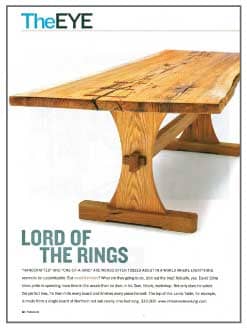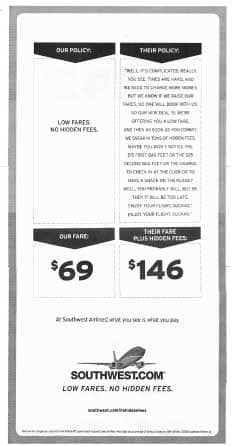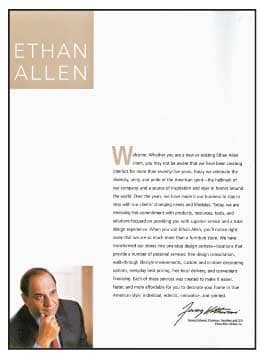Seven Lost Ad Secrets Part 6: How to answer this question and turn your furniture store into a Blue-Ocean selling machine.
Advertising Magic by Larry Mullins
Years ago a famous politician lost his chance to get his party’s nomination for president because he could not answer a very basic question. He had a powerful machine behind him, tremendous name recognition, and virtually unlimited financing. But when, on national television, a commentator asked this famous man: “Why do you want to be president?” he fumbled and mumbled and could not give a clear answer. As a result, the golden moment was lost and his aspirations to become president were no longer taken seriously.
Now imagine yourself in a similar spot. A shopper is sitting across from you at your desk and suddenly asks you: “Why should I shop for furniture at your store? Why should I give you my business and not a competitor?” What would your answer be? How would you distinguish yourself, your brand, your offerings?

The table shown here was featured in Forbes magazine recently. It is an example of the art of creative merchandising. To me, it looks like a tough sell at any price. But juice it up with some far out copy, an intriguing story about the woodsman, and you have a feature item for a prestigious magazine. According to the article, the table was created from a single, carefully selected tree, and then personally hand milled by the builder. We are told the top is made from a single board of Northern red oak, nearly nine feet long. Not to my taste, and to me it is a bit pricey at $10,000 (to put it mildly). However, this feature does demonstrate the power of professional copy to enhance perceived value.
Would you say: “We offer famous brands and guaranteed lowest prices.” So says everyone else. Would you say: “We have a great selection and good salespeople.” So says everyone else. “We offer three years free financing.” So says everyone else. And on and on it would probably go. Now, if you had some time to think about the deeper question, you would likely do better. The deeper question is: “How will your furniture store contribute more to my family’s health, happiness and well being than your competitors?” What answer can you give that will wow that customer? Forget great selection and displays and the most service-minded associates. Customers have heard all that.
So, what unique services can a middle-of-the-road store offer that will lift it out of the red ocean and make competitors irrelevant? And how can you communicate this value to your customers? You are about to find out.
However, you are lucky. The big boxes don’t know how to answer this key question either. You have a brief window of opportunity to become a Blue Ocean selling machine before they catch on.
If Blue Ocean does not mean anything to you, you need to read, “Blue Ocean Marketing Can Make Your Competitors Irrelevant - Part 1”, posted to the Marketing Management article archives on furninfo.com. Briefly, Blue Ocean is an arena you own because of your unique factors, your brand, and the things that distinguish you from the herd.
 |
In this very aggressive ad Southwest gives a clear answer to the consumer who asks the question above. “Because we have low fares and no hidden fees.” There can be no doubt that Southwest gives you more for your money. This is the kind of killer ad that builds market share in tough times. |
There are two general parts to the Blue Ocean process. The first is to cut out waste and create a vision of the company you want to have this time next year. What unique selling propositions or services can you create at a reasonable cost that will make you stand out advantageously from competition in the eyes of your customers, associates, and vendors? What powerful and unique benefits can you offer that your competition has yet to think of? Second, you need to get the word out in the most cost-effective way possible. The more effectively you telegraph your real and perceived advantages the more often prospects will choose you over your competition.
Some of the ideas that follow on how to become a Blue-Ocean selling machine will appeal to you, and some will not. Cherry-pick the best concepts and then brainstorm with your associates to come up with others. Then craft them all into a plan.
BECOME A BLUE-OCEAN SELLING MACHINE
It may come as a surprise that to begin the Blue Ocean process you aren’t confronted with new ways of spending money and time, but rather ways of eliminating waste—both time and money waste. We are going to demolish some sacred cows along the way. Recall that in FURNITURE WORLD’s September 2006 Blue Ocean article, Cirque du Soleil achieved revenues in twenty years that exceeded the gross volume Ringling Bros. and Barnum and Bailey took over one hundred years to achieve. And Cirque du Soleil did it in an industry that was on the decline. They did this with a Blue Ocean concept called Value Innovation. Rather than a slow, incremental value-added improvement, equal measures of value and innovation are applied to vault the product beyond what we imagine buyers are willing to accept and pay for. The first step for Cirque du Soleil was to examine the expensive sacred cow assumptions about the circus: star-power, animals, and three rings of non-stop action. Remember this first step: Examine the following four wasteful assumptions that most home furnishings have, that tend to hobble their advertising and marketing efforts.
Assumption #1
“Me too” advertising that is expensive and ineffective is better than no advertising at all.
Here is your first Blue Ocean opportunity to cut needless waste. Quit paying top dollar for advertising white space and filling it with weak label headlines and boring copy. Stop allowing precious prospects to leave your store empty-handed, without a “silent salesperson” brochure that tells your story and unique selling propositions in compelling words and pictures. Learn how to double or triple the power of your advertising copy and you’ll stand out from the competition instantly. Give your sales consultants new tools in the form of powerful short phrases and scripts that enhance the value of your products and services while fascinating and engaging guests who visit your store.
 |
Farooq Kathwari leaves no doubt about why he believes Ethan Allen is the best source for home furnishings. First off, he says Ethan Allen has seventy-five years experience in home decor. Then he makes the claim that Ethan Allen is “much more than a furniture store.” This would be an empty claim if he did not support it with facts, which he does with great skill: “We have transformed our stores into one-stop design centers—locations that provide a number of personal services: free design consultation, walk-through lifestyle environments, custom and in-store decorating options, everyday best pricing, free local delivery, and convenient financing. Each of these services was created to make it easier, faster, and more affordable to decorate your home in true American style: individual, eclectic, innovative and spirited.” The middle of the road independent who can write copy to create an equally vivid brand and compelling list of unique selling factors will create their own “Blue Ocean” and be hard for competitors to catch. |
Most independent home furnishings retailers and big boxes simply don’t get it. Check out their ads. Note the repetitive label headlines and the dry as dust copy.
Compare them with the engaging, selling copy of an Ethan Allen catalogue. One day a middle of the road big box will realize it needs top advertising writers and it will be too late to beat them to the punch. Act now and start learning about salesmanship in print. Start by visiting www.furninfo.com and browse the marketing article archives. Key in the search term “Larry Mullins” and read, “Advertising Principles, Who Writes Your Ad Copy?”, “Visionary Selling - Part 1 - Take The Time To Understand Deliver Priceless Value” and “Powerful Advertising Suggestions”. You will find other articles of interest there as well, and a huge reservoir of selling tools. But get started soon.
If you simply cannot do it yourself, delegate the task of learning to use the power of the printed and spoken word to someone else in the organization. Support them in their quest to master the “greatest money-making skill of all time” that according to the book, “Guerrilla Marketing” by Jay Levinson is world-class copywriting.
Assumption #2
Time constraints make it necessary to carry sales people who aren’t adequately trained and have unproductive down time.
One of the prevailing ideas today is that young people cannot be motivated. The fact is they are less motivated by money than by an opportunity to learn a valuable skill.
If you sponsor a sales consultant or office person, for example, to learn the advertising principles that will multiply the power of your messages, you will likely find he or she will respond with enthusiasm. There are other ways to utilize the down time of sales consultants. One of the most important is to train an associate in the art of decorating with an eye toward developing a new profit center, a “House Calls” program.
If you are a smaller store, at first a single design-trained consultant can handle the calls for you. This individual can also train the rest of your associates in decorating basics. A good House Calls program will follow a step-by-step procedure: (a) The client interview, (b) The house call and the measurements, (c) The trip to the store by the client to see the floor plan and to make major furniture choices, (d) accessorizing choices and (e) the close and financing. One large Denver store has this down so well that they close over 90% of their house calls. Of course, house calls are also Ethan Allen’s bread and butter; it is featured in every flyer they produce. Look into it, you can do it too. For more details see the furninfo.com online articles, “Make Your Competitors Irrelevant” and “Make More House Calls”.
Assumption #3
The belief that “they know us” and it’s not necessary to continually interface with the community in creative ways.
Among the beliefs that lower furniture store sales volume and profits is the conviction that you are advertising to a static target market. You are not. You are advertising to a moving parade. Prospects come and go very rapidly.
Using ordinary media to attract them into your store at the perfect moment is very, very expensive. Imagine, for example, a decorator running a newspaper ad promoting her services. What are the odds she will get response?
Very small. Now imagine her running an ad announcing a free seminar on an important issue like color basics, or getting more for your money when you buy furniture fashions. Prospects would respond, she could give them valuable information, and they would leave with her professional brochure. Most important, she would begin building a relationship with many new prospects.
You too, at very small expense, can cut your promotional costs and attract good prospects to your store on a regular basis. Sound too good to be true? Not at all. Simply stage a series of free homemaker events, including decorating basics, buying the right mattress, knowing quality in furniture, etc. Prospects will flock to your door, provided these events are carefully planned and professionally executed. For complete information check out the excellent series (Lesson 7b is in this issue) on conducting consumer seminars by Margarett DeGange at www.furninfo.com.
Assumption #4
Many associates don’t care and need not be brought into the loop of communication.
A few years ago I was consulting for a large furniture company, and happened to be going through a swinging door just ahead of a warehouseman. I held the door as he walked through. He seemed surprised, and said: “That is the first time a guy in a suit ever held the door for me.”
This company prided itself on its values, especially one expressing this philosophy: “our associates are our most important assets.” Something did not compute. Indeed, I was to learn that this guy came from the “back end,” the warehouse. In this company he was thus automatically on a lesser level than the rest of the associates. The excuse usually given for this classification is that the “back end people” are indifferent and don’t hang around very long anyway. This is a huge mistake.

This unusual store-closing format (far left) is heavy on the copy, but people definitely read it. People love to read stories, especially stories about other people. The ad is a big morale booster as well. This kind of ad is difficult to create, but it always proves to be vastly more cost effective than price-item, label headline advertising.
One of the most damaging sacred cows that furniture entrepreneurs worship is the premise that “People will not read much copy.” Research indicates the opposite. The promotional ad (near left) ran most recently in the Wall Street Journal. It was created by pros and is obviously working (It runs several times a year). The deal is this: You can buy the heater for $249 (limit two per customer). Or you can buy the Amish mantle for $299, and you get the heater free.
A good organization is like a family. There are no poor relatives, only human beings doing certain duties. All contribute to the whole… even the lowly vendors! Very few organizations have achieved the management success of the early days of Disneyland and Disney World. The following story is worth repeating. Walt Disney died before Disney World was completed in Florida. His brother Roy took the reins. It so happened that one morning during the construction of Disney World Roy entered the main trailer and spotted a new sign. The sign read: “ALL VENDORS GO TO REAR ENTRANCE.” Roy removed the sign and took it inside with him. He called his crew together and said: “I don’t know who put this sign up. It doesn’t matter. Here at Disney, we don’t operate the way this sign reads. We treat everyone with respect. Not just associates and customers and the community. Everyone. Including, and maybe even especially, our vendors.”
Roy Disney knew that the first place where most organizations begin to allow slippage and lack of respect is how they treat their vendors. Generally vendors must suffer in silence, they have to stuff their feelings.
However, I want to point out that disrespectful treatment to anyone is the direct result of a company’s culture. And a company’s culture is the responsibility of the individual at the top. Since most vendors have no recourse, they are especially vulnerable to rankism. Roy Disney was an exceptionally enlightened CEO. When he spotted deterioration in the Disney culture he moved quickly to correct it.
But, what does this have to do with selling more furniture? Just this: we must be aware that when a manager fails to uphold the value of human dignity, it sets into motion a dynamic that draws our attention away from whatever we are doing—including serving customers and selling furniture.
Failure or deterioration in this factor must be attended to quickly, with passion, and with surgical objectivity. That factor is the culture of the organization. When left to their own devices, less enlightened managers can foster an abuse of rank that will soon spread like a virus to other associates. Never sanction rankism in any form. A small leak can eventually sink even a great ship.
CONCLUSION
Brainstorm with your staff for other issues that may be costly and in need of elimination or modification. After elimination of several wasteful sacred cows, you will be poised for the final step. In the next and final article in this series you will find out how to put all the parts together to create a profitable Blue Ocean home furnishings selling machine that will make your competition irrelevant. In the meantime, forget bragging about great selection and displays and the most service-minded associates. Customers have heard all that. Start thinking about the unique services you now offer and the new ones you can create to lift your store out of the red ocean of “me too” and make competitors irrelevant.
Contributing Editor Larry Mullins has 30+ years experience in the front lines of furniture marketing. Larry’s mainstream executive experience, his creative work for “promoter-specialists,” and his study of advertising principles has enabled him to develop cost-effective turn-key High-Impact programs. These include everything from cash-raising events to complete exit strategies. New, edge-of-the-art computerized technology makes these exciting, fully customized programs affordable for even smaller furniture merchants. Larry is the President of UltraSales, Inc.. Questions about this article can be sent to Larry care of FURNITURE WORLD Magazine to mullins@furninfo.com. See more articles by Larry in the marketing management archives on furninfo.com.